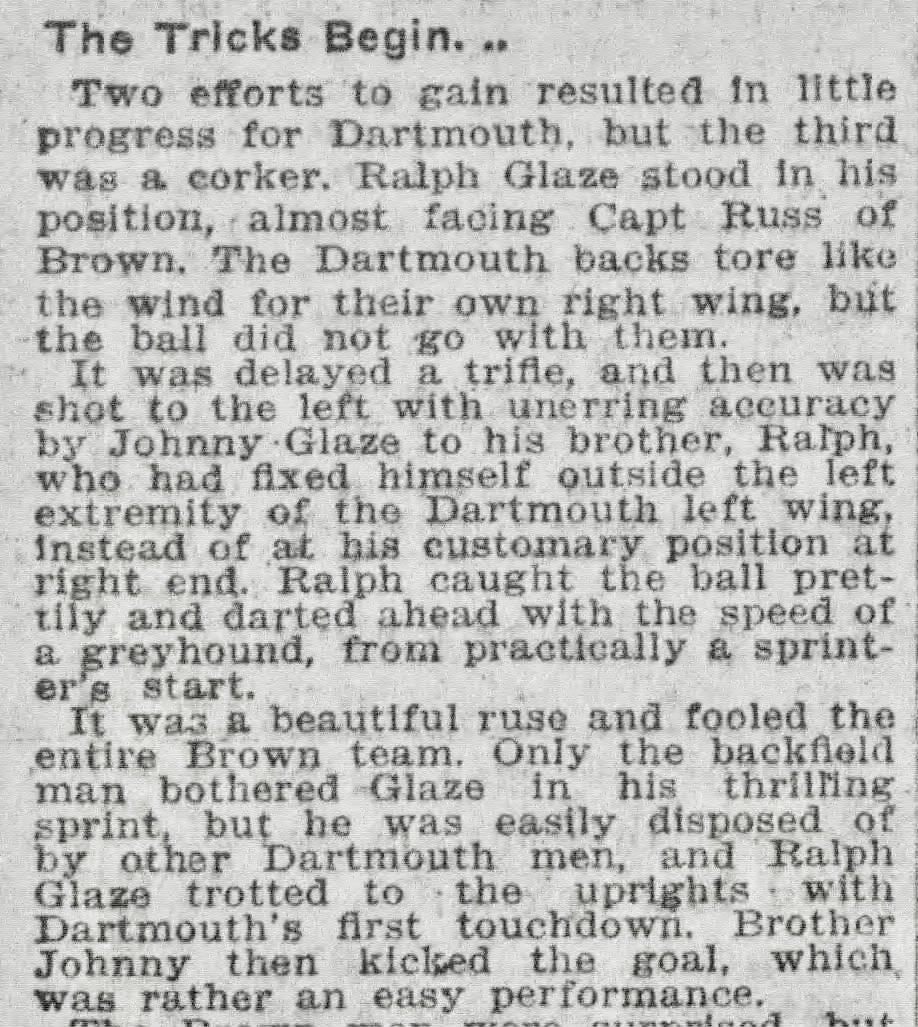Today's Tidbit... Football On A Shoestring Play
A recent Tidbit reviewed the history of the hidden ball trick, often credited to Pop Warner but conceived by John Heisman. Warner is also commonly credited with inventing the "shoestring play," though that story is also unlikely.
The shoestring play has several variations or imitators. One take saw use in the days before hash marks when, for example, a player swept to the right and was tackled toward the right sideline. While the players on both teams lined up near the ball on the right side of the field, a teammate lingered on the left, appearing to tie his shoe so the defense would ignore him. At the snap, the quarterback threw a long lateral to the pre-1906 shoestringer or a forward pass to the 1906 and beyond shoestringer. Another variation had the lingering player lie down on the far side of the field so the opponent would not see him before the snap.
Given that there are variations on this trick play theme and there were likely different names for these plays, it is difficult to determine when they originated, but it is unlikely that Pop Warner conceived the play.
Pop Warner was a junior lineman at Cornell in 1893, the same year that Princeton and Yale met on Thanksgiving Day, a game Princeton won to finish 11-0 and earn the championship. Recalling the contest thirty years later, Phil King, Princeton's quarterback, remembered their right end and team captain, Thomas Trenchard, getting the ball and making a long lateral to King, who had lingered on the other side of the field. While that was King's recollection, a newspaper report from the day after the game indicated that King had thrown the ball to Morse, Princeton's right halfback, an arrangement that makes more sense given the players' positions.

In any event, King's recollection and the newspaper article suggest the shoestring saw use before Warner captained Cornell or began his coaching career.
The first report of the shoestring play being used in a game and called by that name came in 1904 when Utah earned a long gain against Colorado. The next description of the shoestring comes in 1905 when John Glaze, Dartmouth's quarterback, made a long pass to his brother Ralph versus Brown. (The 1905 game was in the pre-forward pass era, so their pass was our lateral.)
When Ralph Glaze described the play in an interview a few years later, they referred to it as the shoestring play.
From there, reports of shoestring plays are found in high school and college games across the country in the pre-WWI days before they began petering out. Still, the shoestring play remained in teams' repertoires. Stagg included a forward pass version of the shoestring in a syndicated series of plays in the mid-1920s, and Zuppke had it in his Ned Brant cartoon series of the 1930s.

Two other variations on the trick play occurred recently enough to have been captured on film. One came in the 1969 Duke-North Carolina game when Duke called a shoestring play with the game in a 7-7 third-quarter tie. Duke's quarterback acted like he was tying his shoe, leading the UNC defense to remain huddled. Then, a Duke end went in motion, took a direct snap from center, and ran around the left end for a touchdown.
A few years later, Georgia led Vanderbilt 7-3 when Vince Dooley chose to spark his Bulldog team, so he called another variation of the shoestring. Like Duke's version, Georgia's quarterback tied his shoe while the other Bulldogs lined up to the ball's left as Vandy's defense huddled. The quarterback then walked up to the ball, snapped it to a back, and the wall of blockers led the back downfield for a Georgia touchdown.
Unfortunately for Georgia, they tried the same play from deep in their territory while leading the 1976 Cotton Bowl, but they fumbled and lost the ball, allowing Arkansas to score a few plays later.
As always, there have likely been more recent shoestring plays teams have used successfully, but I can't think of them. Of course, if there has been one of note and you have a video link, please add it in a comment below.
Football Archaeology is reader-supported. Click here to buy one of my books or otherwise support the site.




I haven't read if "Doggie" Trenchard ran a shoestring play in either of his stints as UNC coach. Trenchard, whose great-great-granddaughter ended her UNC lacrosse career in 2022, is buried in the Old Chapel Hill Cemetery ~1000-feet from where his football teams played on the Carolina campus.
I wonder if Vince Dooley held on to that shoestring play since 1969 when Duke ran it against his brother.